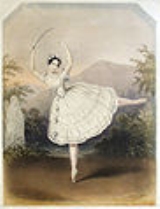
Myrtha, Queen of the Wilis
Encyclopedia

Romantic ballet
The Romantic ballet is defined primarily by an era in ballet in which the ideas of Romanticism in art and literature influenced the creation of ballets. The era occurred during the early to mid 19th century primarily at the Théâtre de l'Académie Royale de Musique of the Paris Opera Ballet and Her...
, Giselle
Giselle
Giselle is a ballet in two acts with a libretto by Jules-Henri Vernoy de Saint-Georges and Théophile Gautier, music by Adolphe Adam, and choreography by Jean Coralli and Jules Perrot. The librettist took his inspiration from a poem by Heinrich Heine...
which premiered at the Paris Opéra
Paris Opera
The Paris Opera is the primary opera company of Paris, France. It was founded in 1669 by Louis XIV as the Académie d'Opéra and shortly thereafter was placed under the leadership of Jean-Baptiste Lully and renamed the Académie Royale de Musique...
's Salle Le Peletier on 28 June 1841. This ballet was choreographed
Choreography
Choreography is the art of designing sequences of movements in which motion, form, or both are specified. Choreography may also refer to the design itself, which is sometimes expressed by means of dance notation. The word choreography literally means "dance-writing" from the Greek words "χορεία" ...
by Jean Coralli
Jean Coralli
Jean Coralli , born Jean Coralli Peracini, was a French dancer and choreographer and later held the esteemed post of First Balletmaster of the Paris Opera Ballet...
and Jules Perrot
Jules Perrot
Jules-Joseph Perrot was a dancer and choreographer who later became Balletmaster of the Imperial Ballet in St. Petersburg, Russia...
and the role of Myrtha, Queen of the Wilis was first performed by ballerina
Ballerina
A ballerina is a title used to describe a principal female professional ballet dancer in a large company; the male equivalent to this title is danseur or ballerino...
Adèle Dumilâtre.
History of the character
The character of Myrtha is somewhat enigmatic, but what the librettoLibretto
A libretto is the text used in an extended musical work such as an opera, operetta, masque, oratorio, cantata, or musical. The term "libretto" is also sometimes used to refer to the text of major liturgical works, such as mass, requiem, and sacred cantata, or even the story line of a...
of the ballet Giselle
Giselle
Giselle is a ballet in two acts with a libretto by Jules-Henri Vernoy de Saint-Georges and Théophile Gautier, music by Adolphe Adam, and choreography by Jean Coralli and Jules Perrot. The librettist took his inspiration from a poem by Heinrich Heine...
seems to tell us is that she, as the queen of the vengeful, ghost-like wilis , holds ultimate power over the magical sisterhood. The wilis do her bidding in the Bavaria
Bavaria
Bavaria, formally the Free State of Bavaria is a state of Germany, located in the southeast of Germany. With an area of , it is the largest state by area, forming almost 20% of the total land area of Germany...
n forest each night between twilight and dawn, seeking only male prey whom they force, with the help of seemingly magical mistletoe
Mistletoe
Mistletoe is the common name for obligate hemi-parasitic plants in several families in the order Santalales. The plants in question grow attached to and within the branches of a tree or shrub.-Mistletoe in the genus Viscum:...
twigs, to dance until their hearts give out—or at least until they are so weak that a few wilis can throw them into a lake if there one is conveniently located nearby.
The Legend
A wiliSlavic fairies
Fairies in Slavic mythology come in several forms and their names are spelled differently based on the specific language. Among the ones listed below there were also khovanets , dolia , polyovyk or polevoi , perelesnyk , lesovyk or leshyi , blud , mara Fairies in Slavic mythology come in several...
is a vengeful, ghostlike creature who was a young virginal woman who has died before her wedding day. This ballet has its origins in a concept by poet and critic, Théophile Gautier
Théophile Gautier
Pierre Jules Théophile Gautier was a French poet, dramatist, novelist, journalist, art critic and literary critic....
, in collaboration with the dramatist Saint-Georges. They took their inspiration from the theme of a Slavic legend known as the "Wiles" or "Wilis" described in the poems of Heinrich Heine
Heinrich Heine
Christian Johann Heinrich Heine was one of the most significant German poets of the 19th century. He was also a journalist, essayist, and literary critic. He is best known outside Germany for his early lyric poetry, which was set to music in the form of Lieder by composers such as Robert Schumann...
. According to Heine, "the Wilis are affianced maidens who have died before their wedding day, but are unable to rest peacefully in their graves, since they could not satisfy during life their passion for dancing. Hence at midnight they rise up and gather in bands on the highway, and lure any young man they meet to fancy with them until he falls dead."

